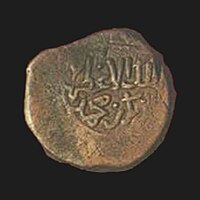
Abū al-ʿAbbās Aḥmad ibn al-Hasan al-Mustaḍīʾ, better known by his laqabal-Nāṣir li-Dīn Allāh or simply as al-Nasir, was the Abbasid caliph in Baghdad from 1180 until his death. His laqab literally can mean The One who Gives Victory to the Religion of God. He continued the efforts of his grandfather al-Muqtafi in restoring the caliphate to its ancient dominant role and achieved a surprising amount of success as his army even conquered parts of Iran. According to the historian, Angelika Hartmann, al-Nasir was the last effective Abbasid caliph.

Abū Nasr Muhammad ibn al-Nāsir, better known with his regnal name al-Ẓāhir bi-Amr Allāh, was the Abbasid caliph in Baghdad from 1225 to 1226. He succeeded his father al-Nasir in the year 1225 as the thirty-fifth Abbasid Caliph.
Buraq Hajib, also spelt Baraq Hajib, was a Khitan who founded the Qutlugh-Khanid dynasty in the southern Persian province of Kirman the early 13th century after the conquest of the sinicised Qara Khitai by the Mongol Empire. The dynasty founded by Buraq Hajib ended in the 14th century.

Maragheh is a city in the Central District of Maragheh County, East Azerbaijan province, Iran, serving as capital of both the county and the district.
Ala ud-Din Timurtash was a member of the Chobanids who dominated politics in the final years of the Ilkhanate.

Shams al-Din Ildeniz, Eldigüz or Shamseddin Eldeniz was an atabeg of the Seljuq empire and founder of the dynasty of Eldiguzids, atabegs of Azerbaijan, which held sway over Armenia, Iranian Azerbaijan, and most of northwestern Persia from the second half of the 12th century to the early decades of the 13th.

The Ildegizids, Eldiguzids or Ildenizids, also known as Atabegs of Azerbaijan were an Atabegate of the Seljuk Empire, and a Sunni Muslim Turkic dynasty, which controlled most of northwestern Persia, eastern Transcaucasia, including Arran, most of Azerbaijan, and Djibal. At their maximum extent, the territory under their control, roughly corresponds to most of north-western Iran, most of the regions of modern Azerbaijan and smaller portions in modern Armenia, Turkey and Iraq. Down to the death in war 1194 of Toghril b. Arslan, last of the Great Seljuq rulers of Iraq and Persia, the Ildenizids ruled as theoretical subordinates of the Sultans, acknowledging this dependence on their coins almost down to the end of the Seljuqs. Thereafter, they were in effect an independent dynasty, until the westward expansion of the Mongols and the Khwarazm-Shahs weakened and then brought the line to its close.

Toghrul III was the last sultan of the Great Seljuk Empire and the last Seljuk Sultan of Iraq. His great uncle Sultan Ghiyath ad-Din Mas'ud had appointed Shams ad-Din Eldiguz as atabeg of his nephew Arslan-Shah, the son of his brother Toghrul II, and transferred Arran to his nephew's possession as iqta in 1136. Eldiguz eventually married Mu’mina Khatun, the widow of Toghril II, and his sons Nusrat al-Din Muhammad Pahlavan and Qizil Arslan Uthman were thus half-brothers of Arslan Shah, but despite close ties with the Royal Seljuk house, Eldiguz had remain aloof of the royal politics, concentrating on repelling the Georgians and consolidating his power. In 1160, Sultan Suleiman-Shah named Arslan Shah his heir and gave him governorship of Arran and Azerbaijan, fearful of the power of Eldiguz.

The Ahmadilis, also known as the Atabegs of Maragheh, Romanized as Atābakān-e Marāghe, were Atabegs of the Seljuk Empire and a local Turcoman dynasty who ruled from the early 12th century until 1208–09 in Maragheh itself and in Ru'in Dez for some years after the Mongol invasion of the Khwarazmian Empire. They ruled approximately from 1122 to 1225.

Jalal al-Din Mangburni, also known as Jalal al-Din Khwarazmshah, was the last Khwarazmshah of the Anushteginid dynasty. The eldest son and successor of Ala ad-Din Muhammad II of the Khwarazmian Empire, Jalal al-Din was brought up at Gurganj, the wealthy capital of the Khwarazmid homeland. An able general, he served as second-in-command to his father in at least one battle; however, since he was the son of a concubine, he was challenged as successor by a younger brother, whose cause was supported by the powerful Queen Mother, Terken Khatun. Nevertheless, after the Mongol conquest of the Khwarazmian Empire led to his father's flight and death on an island in the Caspian Sea, Jalal-al Din gained the loyalty of the majority of Khwarazmian loyalists.
The Khwarazmian or Khwarezmian Empire was a culturally Persianate, Sunni Muslim empire of Turkic mamluk origin. Khwarazmians ruled large parts of present-day Central Asia, Afghanistan, and Iran from 1077 to 1231; first as vassals of the Seljuk Empire and the Qara Khitai, and from circa 1190 as independent rulers up until the Mongol conquest in 1219–1221.

Abu Sa'id Bahadur Khan, also spelled Abusaid Bahador Khan, Abu Sa'id Behauder, was the ninth ruler of the Ilkhanate, a division of the Mongol Empire that encompassed the present day countries of Iran, Azerbaijan, Georgia, and Armenia, as well as parts of Iraq, Turkey, Afghanistan, and Pakistan. After his death in 1335, the Ilkhanate disintegrated.
Nusrat al-Din Muhammad ibn Ildeniz, better known as Muhammad Jahan-Pahlavan, was the ruler (atabeg) of the Eldiguzids from 1175 to 1186. He was the son and successor of Eldiguz, and was later succeeded by his brother Qizil Arslan.
Qutb al-Din Mohammad — was Qutlughanid ruler of Kerman and a nephew of Buraq Hajib, founder of dynasty.
Tamta Zakarian or Tamta Mkhargrdzeli was an Armenian Chalcedonian Christian noble woman of Kurdish descent, born at the court of queen Tamar of Georgia. She appears in only a few written sources, including contemporary histories by Kirakos Gandzaketsi and Vardan Areveltsi.
The High Middle Ages, or Classic Feudalism Period in what constitutes the present-day Republic of Azerbaijan, lasted from around the 11th century to the 15th century AD. The High Middle Ages were preceded by the Early Middle Ages and were followed by the Late Middle Ages, which ended around the 15thcentury AD. Key historical trends of the High Middle Ages include the incorporation of the territories that constitute present-day Azerbaijan into the Seljuk Empire, the establishment of the Eldiguzids, the Mongol invasions and the rule of the Ilkhanate, the invasions of Timur and the establishment of the Turkoman Kara Koyunlu and Aq Qoyunlu tribal confederations.
The Mongol invasions and conquests of the territory that now comprises the Republic of Azerbaijan took place during the 13th and 14th centuries and involved large-scale raids. The Mongol invasions of Azerbaijan resulted in the incorporation of the territories of what now comprises Azerbaijan into the newly established Hulagu state.
Sulafa Khatun, was the ruling atabeg of Maragha between 1209-1225. She was the last member of the Ahmadilis dynasty and its only female ruler.

The Khwarazmian army, also called the Khwarazmiyya, maintained itself as a force of freebooters and mercenaries between 1231 and 1246, following the Mongol conquest of the Khwarazmian Empire (1221) and the death of the last Khwarazmshah, Jalal al-Din (1231). It was active in Upper Mesopotamia, Anatolia, Syria and Palestine and shifted its allegiance several times, often acting autonomously before it was defeated and destroyed by the Ayyubids.
Rū'īn Dez, sometimes also called just Rū'īn, was a fortress near Maragheh in Iran that served as the main dynastic stronghold and residence of the Ahmadili Atabegs of Maragheh in the 1100s and early 1200s. Vladimir Minorsky tentatively located it at present-day Yayshahr, 16 km north of Maragheh on the slopes of Mount Sahand. In 1174/5, the Eldiguzid ruler Muhammad Jahan Pahlavan besieged Ru'in Dez and then Maragheh, each time unsuccessfully. In 1197, when the poet Nizami Ganjavi completed his Haft Peykar, he sent it to his patron, the Ahmadili atabeg Ala ad-Din, who received it at Ru'in Dez. After Ala ad-Din died in 1207 or 1208 and then his young son died a year later, the Eldiguzid atabeg Abu Bakr invaded Ahmadili territory. A eunuch who stayed loyal to the Ahmadili family took up a defensive position at Ru'in Dez with Sulafa Khatun, Ala ad-Din's granddaughter, along with the dynastic treasury. Ru'in Dez was the only Ahmadili possession that did not come under Abu Bakr's control. Sulafa Khatun remained in charge at Ru'in Dez after the Mongols took Maragheh itself in 1220 or 1221. Her reign came to an end after a siege of Ru'in Dez by the Khwarazmshah vizier Sharaf al-Molk when Jalal al-Din Mangburni arrived, made her marry him, and installed a new governor at Ru'in Dez.











